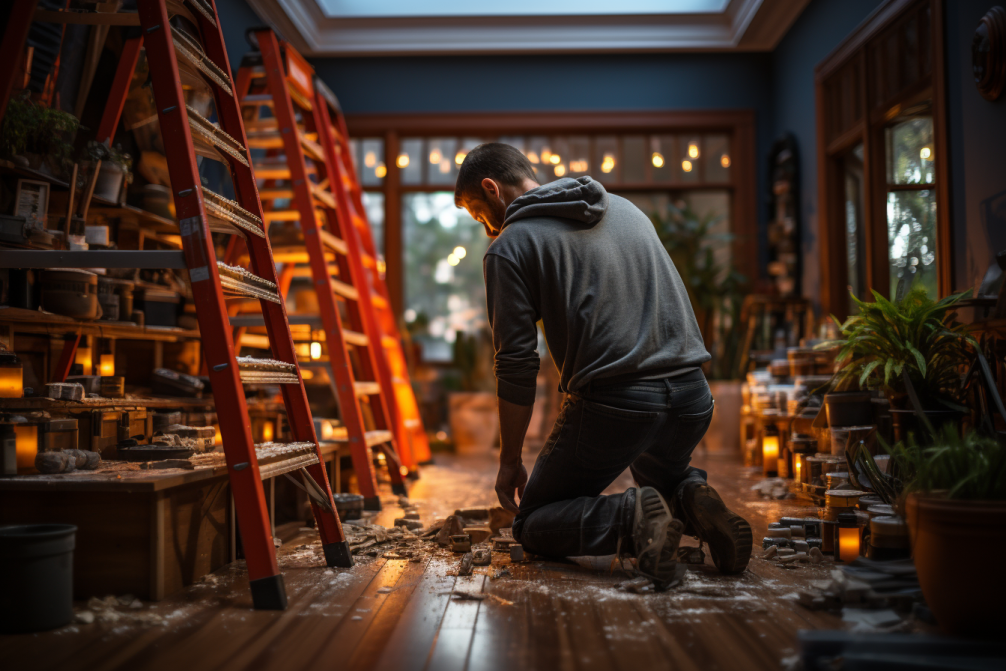Table of Contents
Overcoming Obstacles: Expert Tips for Conquering Common Home Improvement Hurdles
Hey there, DIY enthusiasts and homeowners looking to spruce up your space! We all know that embarking on a home improvement project can be both exciting and overwhelming. From a leaky faucet to a squeaky floorboard, we often encounter a myriad of challenges along the way. But fear not! In this guide, we’ll equip you with the tips and tricks to tackle those pesky hurdles head-on.
Whether you’re a newbie or a seasoned handyman, there’s an endless list of common home improvement challenges that can leave you scratching your head. Plumbing mishaps, electrical issues, uneven walls – they can all put a wrench in your plans. But fret not! With a little knowledge and ingenuity, you can overcome these obstacles and turn your house into the dream home you’ve always envisioned.
Get ready to roll up your sleeves and dive into the world of home improvement as we share practical advice, step-by-step instructions, and creative solutions to tackle those irritating problems that seem to plague every homeowner. From fixing a leaky roof to updating your outdated kitchen, we’ve got you covered.
So, whether you’re looking to save some money on repairs, boost your DIY skills, or just enjoy the satisfaction of a well-improved home, this guide is your go-to resource. Say goodbye to frustration and hello to success as we embark on this journey together. Let’s roll up our sleeves, grab our tools, and tackle those common home improvement challenges with confidence!
Identifying and Fixing Plumbing Issues: A Step-by-Step Guide
From a dripping faucet to a clogged drain, plumbing issues are a common headache for homeowners. But fear not! With a little know-how and the right tools, you can become a DIY plumbing expert and tackle those pesky problems with ease. Get ready to roll up your sleeves and dive into the world of pipes and valves with this step-by-step guide on how to identify and fix plumbing issues in your home.
1. Leaky Faucets and Pipes
- Inspect the faucet for any visible leaks and tighten any loose connections.
- Replace worn-out washers or O-rings by turning off the water supply.
- For leaky pipes, use plumber’s tape or epoxy putty to temporarily stop the leak until repairs can be made.
2. Clogged Drains
- Try using a plunger to unclog the drain. Create a tight seal and use firm, rhythmic plunges to dislodge the clog.
- If plunging doesn’t work, use a plumbing snake or auger to reach deeper into the pipes and break up the obstruction.
- For stubborn clogs, consider using a chemical drain cleaner as a last resort, following the instructions carefully.
3. Running Toilets
- Lift the tank lid and check if the flapper valve is properly seated. Adjust or replace it if necessary.
- Look for any leaks in the tank or the flush valve. Replace faulty parts to prevent water wastage.
- Check the water level in the tank and adjust the float ball or fill valve to ensure a proper water level, which can improve the flushing mechanism.
4. Low Water Pressure
- Remove and clean faucet aerators or showerheads, as they can get clogged with mineral deposits.
- Check for any leaks or obstructions in the water supply line.
- If the issue persists, consult a professional plumber to investigate any potential problems in the main water line or pressure regulator.
Remember, safety is paramount when dealing with plumbing issues. If you feel uncertain or overwhelmed, don’t hesitate to seek professional help. With these step-by-step instructions, you can confidently tackle common plumbing challenges and keep your home’s waterworks running smoothly.
Electrical Woes: Troubleshooting and Safety Tips
Dealing with electrical issues in your home can be both frustrating and dangerous. From a flickering light to a tripped circuit breaker, it’s important to know how to tackle common electrical problems while prioritizing safety. Get ready to put on your safety goggles and grab your voltage tester as we dive into troubleshooting and safety tips for dealing with electrical woes.
1. Flickering Lights
- Start by checking if the light bulb is properly screwed in and not loose. Replace the bulb if necessary.
- If the problem persists, it could be due to a loose connection in the electrical wiring. Turn off the power to the circuit and try tightening any loose wire connections inside the light fixture.
2. Tripped Circuit Breakers
- Identify which circuit breaker has tripped by looking for the one that is in the middle or “off” position.
- Safely reset the circuit breaker by flipping it fully to the “off” position and then back to the “on” position.
- If the circuit breaker continues to trip, unplug any appliances or devices on that circuit, as they may be overloading it. If the issue persists, consult a licensed electrician.
3. Dead Outlets
- Check if the outlet is receiving power by plugging in a working device. If it doesn’t work, it may be a problem with the outlet itself.
- Use a voltage tester to ensure there is no electrical current running through the outlet before diagnosing or replacing it.
- If you’re comfortable with electrical work, you can replace the outlet following proper safety precautions. Otherwise, consult an electrician.
4. Safety First
- Always turn off the power to the circuit you’re working on before troubleshooting or making any repairs.
- Use non-contact voltage testers to check if power is still present, even if the circuit appears to be off.
- Avoid working with electrical systems in wet conditions or with damp hands to prevent electrical shocks or accidents.
Remember, electrical work can be dangerous, especially if you’re not experienced. If you’re uncertain about any repairs or troubleshooting steps, it’s best to consult a licensed electrician. By following these troubleshooting and safety tips, you can address common electrical issues in your home while keeping yourself and your property safe.
Dealing with Uneven Walls and Ceilings: Techniques for a Flawless Finish
Uneven walls and ceilings can be eyesores in your home, but fear not! With a little know-how and some handy techniques, you can restore a smooth and flawless finish to your surfaces. Get ready to grab your putty knife and sandpaper as we dive into the essential techniques for tackling uneven walls and ceilings.
1. Fill in the Gaps
- Start by inspecting the surface for any cracks, dents, or holes. Use a putty knife to apply spackling compound or joint compound to fill in these imperfections.
- Make sure to feather out the edges of the compound to blend it seamlessly with the surrounding wall or ceiling.
2. Level the Surface
- For larger irregularities or bumps, you may need to use joint compound combined with drywall tape.
- Apply a thin layer of joint compound over the tape, using a trowel or putty knife, and feather out the edges for a smooth transition.
3. Sand and Smoothen
- Once the compound has dried, use sandpaper to gently sand the repaired areas until they’re flush with the rest of the surface.
- Be sure to wear a dust mask to protect yourself from the fine particles.
4. Prime and Paint
- Before painting, apply a coat of primer to the repaired areas to ensure proper adhesion and uniform color.
- Once the primer is dry, you can paint over the surface to achieve a seamless finish.
Remember, patience and attention to detail are key when working with uneven walls and ceilings. Take your time to ensure each step is done thoroughly, and don’t hesitate to seek professional help if the damage is extensive or beyond your expertise. By following these techniques, you can transform those rough surfaces into visually appealing walls and ceilings that will make your home shine.
Handling Flooring Problems: From Squeaky Boards to Damaged Tiles
Flooring problems can be a real headache, but don’t worry – we’ve got you covered! Whether you’re dealing with squeaky floorboards or damaged tiles, there are effective solutions that can help you tackle these common flooring challenges. Get ready to put on your work boots and dive into the world of floor repairs with these essential tips.
1. Squeaky Floorboards
- Identify the location of the squeak by walking over the affected area. Have someone else pinpoint the exact spot.
- Apply a generous amount of powdered graphite or talcum powder into the gaps between the squeaky boards. This helps to reduce friction and eliminate the annoying noise.
- If the squeak persists, use a specialized squeaky floor repair kit that includes screws or joist braces. Follow the manufacturer’s instructions to secure the boards and eliminate the squeak.
2. Damaged Tiles
- Remove any loose or damaged tiles using a grout saw or chisel. Be careful not to damage surrounding tiles.
- Clean the area thoroughly and ensure it’s free from any debris or adhesive residue.
- Apply a thin layer of tile adhesive to the back of the new tile and firmly press it into place.
- Let the adhesive dry completely before grouting the tile and sealing the joints.
3. Scuffed or Scratched Hardwood Floors
- Clean the affected area using a hardwood floor cleaner or a mixture of warm water and mild soap.
- For minor scuffs or scratches, use a hardwood floor touch-up marker that closely matches the color of your floor. Apply it carefully, following the wood grain.
- For deeper scratches, you may need to sand the area lightly and apply a wood filler that matches the color of your floor. Once dry, sand it smooth and apply a protective coat of polyurethane.
Remember, it’s important to take proper safety precautions and follow the manufacturer’s instructions for any repair products or tools you use. If you’re unsure or the problem seems too complex, don’t hesitate to consult a professional flooring contractor for guidance. By tackling these flooring problems head-on, you can maintain the beauty and functionality of your floors for years to come.
Painting Woes: Solving Common Painting Dilemmas
Painting is a popular home improvement project, but it’s not without its challenges. From uneven paint application to stubborn stains, there are several common painting dilemmas that can put a damper on your plans. Fear not! With a little know-how and a few handy tips, you can conquer these painting woes and achieve a professional-looking finish. Let’s dive in!
1. Uneven Paint Application
- Always start with properly prepped walls, ensuring they are clean, dry, and free of any imperfections.
- Use high-quality brushes and rollers to achieve smooth and even coverage.
- Apply paint in a crisscross or “W” motion to ensure proper distribution and minimize streaks.
2. Paint Drips and Runs
- Avoid overloading your brush or roller with paint. Remove excess paint by lightly tapping it against the edge of the paint tray.
- Apply thin layers of paint, allowing each coat to dry completely before applying the next.
- If drips or runs occur, gently sand them once the paint has dried and reapply a thin layer to blend it seamlessly.
3. Stains Bleeding Through Paint
- Primer is your best friend when dealing with stubborn stains. Apply a coat of stain-blocking primer to prevent them from bleeding through your fresh paint.
- Make sure to properly clean and treat the stained area before priming and painting to ensure the best results.
4. Color Fading or Mismatching
- Always purchase enough paint for the entire project and mix cans together to achieve a consistent color throughout the room.
- If you’re unsure about the color, it’s a good idea to test it on a small area or get a sample pot to see how it looks in your space before committing to a whole room.
Remember, patience and attention to detail are key when it comes to painting. Take your time, prepare your surfaces properly, and have the right tools and materials on hand. If you’re facing a particularly challenging painting dilemma or lack confidence in your skills, don’t hesitate to consult painting professionals for their expertise. By following these tips and techniques, you’ll be well on your way to overcoming common painting problems and achieving a beautiful, flawless finish.
Upgrading Your Kitchen on a Budget: Smart Remodeling Solutions
Dreaming of a stylish and functional kitchen but working with a tight budget? You’re not alone! With some savvy choices and creative ideas, you can give your kitchen a fantastic makeover without breaking the bank. Get ready to roll up your sleeves and transform your cooking space with these smart remodeling solutions.
1. Cabinet Upgrades
- Consider repainting or refinishing your existing cabinets instead of replacing them. A fresh coat of paint or a new stain can instantly breathe new life into your kitchen.
- Swap out the old hardware, such as handles and knobs, for newer, more modern options. It’s an easy and affordable way to update the look of your cabinets.
2. Countertop Refresh
- Opt for cost-effective countertop materials like laminate or butcher block. These options can provide a fresh look without breaking the bank.
- If your budget allows, consider investing in a new countertop for a more durable and visually appealing upgrade.
3. Creative Backsplash
- Explore affordable backsplash options like peel-and-stick vinyl or adhesive tiles. These can mimic the look of more expensive materials while being easy to install and budget-friendly.
- Another budget-friendly option is to paint a backsplash using specialty paint that is designed for this purpose.
4. Lighting Enhancements
- Install new light fixtures or update existing ones to give your kitchen a modern and inviting ambiance. Look for budget-friendly options at home improvement stores or online.
- Consider adding under-cabinet lighting to brighten up your workspace and create a more functional kitchen.
5. Affordable Appliance Updates
- Instead of replacing all your appliances, focus on the ones that are outdated or no longer functioning properly. Look for sales, scratch-and-dent options, or consider buying used appliances to save money.
Remember, smart planning and prioritizing are key when remodeling your kitchen on a budget. Set a clear budget, research affordable options, and focus on upgrades that will have the most impact. Don’t be afraid to get creative and DIY where possible. With these smart remodeling solutions, you can create a beautiful, functional kitchen that fits your budget and exceeds your expectations.
Reviving Your Bathrooms: Easy Fixes for Common Bathroom Problems
Is your bathroom in need of a little rejuvenation? From leaky faucets to outdated fixtures, there are common bathroom problems that can put a damper on your daily routine. But fear not! With some simple fixes and a bit of creativity, you can give your bathroom the makeover it deserves. Get ready to roll up your sleeves and tackle these common bathroom challenges with ease.
1. Leaky Faucets
- Tighten any loose connections beneath the sink using a wrench.
- Replace worn-out washers or cartridges to stop the leaks. You can find replacements at your local hardware store.
2. Clogged Drains
- Use a plunger to unclog minor drain blockages. Create a tight seal and plunge vigorously to dislodge the debris.
- For stubborn clogs, try using a drain snake or auger to reach deeper into the pipes and break up the obstruction.
3. Cracked Tiles or Grout
- Remove any loose or damaged tiles using a grout saw or chisel. Clean the area thoroughly, removing any old adhesive or grout.
- Replace the cracked tiles with new ones, applying fresh adhesive and grouting to ensure a strong and seamless finish.
4. Outdated Fixtures
- Update your bathroom’s appearance by replacing old fixtures like faucets, showerheads, and towel racks. Look for budget-friendly options that match your style.
5. Dull or Dingy Walls
- Refresh your bathroom walls with a fresh coat of paint. Choose moisture-resistant paint specifically for bathrooms.
- Consider using bold or light colors to create a visually appealing and spacious atmosphere.
Remember, safety is paramount when dealing with any home improvement project. If you’re unsure about any repairs or lack the necessary skills, it’s best to consult a professional. By addressing these common bathroom problems head-on, you can transform your space into a rejuvenated oasis that you’ll love spending time in.
Outdoor Maintenance Made Simple: Tips for Tackling Yard and Exterior Issues
Maintaining the outdoor areas of your home can feel like a daunting task, but with a little know-how and some simple tips, you can keep your yard and exterior looking their best. From lawn care to tackling exterior issues, we’ve got you covered. Get ready to put on your gardening gloves and tackle these common outdoor maintenance challenges with ease.
1. Lawn Care
- Regularly mow your lawn to maintain a neat and healthy appearance. Set your mower to the appropriate height for your grass type.
- Water your lawn deeply and infrequently, aiming for 1-2 inches of water each week. This encourages strong root growth.
- Stay on top of weeds by pulling them or using a targeted herbicide. Apply fertilizers and lawn treatments as needed to promote a lush lawn.
2. Garden Upkeep
- Remove dead or dying plants to keep your garden looking fresh and tidy. Prune shrubs and trees to maintain their shape and health.
- Regularly weed your garden beds to prevent unwanted plants from taking over.
- Mulch around your plants to help retain moisture, suppress weed growth, and provide a finished look.
3. Exterior Cleaning
- Pressure wash your exterior surfaces, such as the siding, deck, and patio, to remove dirt, mold, and mildew.
- Clean your windows and gutters regularly to maintain their functionality and improve the overall look of your home.
- Regularly inspect and clean outdoor fixtures, such as lights and outdoor furniture, to preserve their longevity.
4. Fixing Exterior Issues
- Patch any cracks or gaps in your driveway or walkways. Use a suitable filler or consider resurfacing if needed.
- Repair any damaged or loose shingles on your roof to prevent leaks and maintain the integrity of your home.
Remember, outdoor maintenance is an ongoing process. Establishing a routine and staying consistent will help keep your yard and exterior in top shape throughout the year. Don’t be afraid to seek professional help for challenging tasks or if you’re unsure of how to proceed. By following these simple tips, you can tackle common outdoor maintenance challenges with ease and ensure that your home’s exterior always looks its best.
Navigating HVAC Challenges: Ensuring Optimal Heating and Cooling
Your HVAC system plays a vital role in keeping your home comfortable throughout the year. From temperature inconsistencies to high energy bills, there are common challenges that homeowners face when it comes to their heating and cooling. Luckily, with a little guidance, you can navigate these HVAC challenges like a pro. Get ready to optimize your home’s comfort with these essential tips.
1. Thermostat Settings
- Take advantage of programmable thermostats to set temperature schedules based on your daily routines. This helps save energy and maintain a comfortable environment.
- Ensure that your thermostat is calibrated correctly. If you suspect it is inaccurate, consider replacing it or adjusting it using a separate thermometer as a reference.
2. Airflow Issues
- Inspect and clean your air vents regularly to ensure proper airflow throughout your home. Remove any obstructions, such as furniture or curtains, that may be blocking the vents.
- Check and replace your air filters every 1-3 months, or as recommended by the manufacturer. This helps maintain good indoor air quality and prevents strain on the HVAC system.
3. Energy Efficiency
- Seal any air leaks around windows, doors, and ductwork to prevent heat loss or infiltration. Use weatherstripping or caulk to seal gaps and cracks.
- Improve insulation in your home’s walls, attic, and crawlspaces to reduce energy loss and improve overall efficiency. Consider adding insulation or upgrading existing insulation where needed.
4. Regular Maintenance
- Schedule professional HVAC maintenance at least once a year to ensure that your system is operating at peak efficiency. A qualified technician can inspect, clean, and tune up the system, helping to prevent breakdowns and prolonging its lifespan.
Remember, if you encounter HVAC challenges that seem complex or beyond your abilities, it’s best to seek professional help. HVAC systems can be complex, and improper handling can lead to further issues or safety concerns. By implementing these tips and staying on top of HVAC maintenance, you can ensure optimal heating and cooling in your home, while also saving energy and promoting a comfortable living environment.
Diving into DIY: Essential Tools and Skills for Home Improvement Success
Ready to take on some home improvement projects? With the right tools and skills, you can tackle common challenges and transform your space. Whether you’re a beginner or a seasoned DIY enthusiast, it’s crucial to have the essentials for success. Get your toolbox ready and let’s dive into what you need to get started!
Essential Tools for DIY Home Improvement
- Hammer: A versatile tool for driving nails and small demolition tasks.
- Screwdriver Set: Have various sizes and types of screwdrivers, including flathead and Phillips.
- Tape Measure: Accuracy is key! Measure twice, cut once.
- Utility Knife: Perfect for cutting materials like drywall or opening packages.
- Pliers: Useful for gripping, bending, and cutting wires or fasteners.
- Adjustable Wrench: Great for tightening or loosening bolts and nuts of different sizes.
- Cordless Drill: Ideal for drilling holes and driving screws quickly and efficiently.
- Level: Ensures your shelves, frames, and fixtures are perfectly straight.
- Safety Gear: Always prioritize safety and have goggles, gloves, and a dust mask on hand.
Essential Skills for DIY Home Improvement
- Basic Carpentry: Learn how to measure and cut materials, as well as how to assemble and install them.
- Painting: Master proper preparation, priming, and painting techniques for a flawless finish.
- Plumbing: Be able to fix common issues like leaky faucets, unclog drains, and replace fixtures.
- Electrical Work: Develop an understanding of electrical safety, basic wiring, and how to replace outlets or switches.
- Tiling: Learn to prepare surfaces, apply adhesive, and grout for a professional tile installation.
- Problem Solving: Sharpen your ability to identify issues, research solutions, and troubleshoot problems that arise during projects.
Remember, it’s okay to start small and slowly tackle more challenging projects as your skills and confidence grow. Invest in quality tools that will last and don’t hesitate to ask for help or seek professional advice when needed. With the right tools and skills, you can successfully conquer common home improvement challenges and take pride in transforming your living space.
Conclusion
In conclusion, tackling common home improvement challenges doesn’t have to be overwhelming. With the right knowledge, tools, and skills, you can overcome these obstacles and transform your living space into the home of your dreams. From plumbing mishaps to flooring problems, we’ve covered a wide range of topics to help you navigate the most common issues that arise during home improvement projects.
Remember to take it one step at a time and be patient with yourself. Rome wasn’t built in a day, and neither will your perfect home. Start with small projects and gradually work your way up to more complex tasks as your confidence and expertise grow.
Don’t forget that mistakes happen, and that’s okay! Home improvement is a learning process, and each project is an opportunity to improve and refine your skills. Dedicate time to research, plan carefully, and always prioritize safety to ensure successful results.
Whether you’re a seasoned DIY enthusiast or just starting on your home improvement journey, remember that every challenge presents a chance to unleash your creativity and turn your house into a space that truly reflects your personality and style.
So, roll up your sleeves, grab your toolbox, and embrace the world of home improvement. With determination, a little elbow grease, and the tips shared in this article, you’re well-equipped to tackle any challenge that comes your way. Happy home improving!









